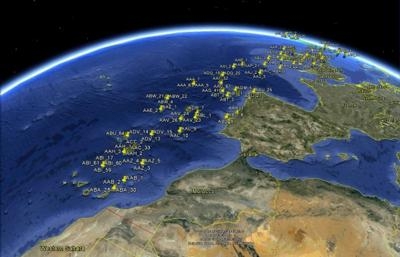Fri, Jun 14, 2013
'Guest Payload' Aboard The Satellite Includes ADS-B Experiment
ESA’s Proba-V has become the first satellite to pick up aircraft tracking signals, allowing aircraft across the globe to be followed in flight from space. “We have succeeded in proving that these relatively low-powered air traffic control signals can indeed be detected from space as they are, without any need for upgraded aircraft equipment,” explained Toni Delovski of the DLR German Aerospace Center, overseeing the experiment. "Now we want to go on and check how many aircraft we can actually observe in practice, and which types – different sized aircraft being assigned systems with differing signal strengths. This research opens the way to operational space-based aircraft monitoring in future.”

Launched on May 7, Proba-V’s main task is to map vegetation growth, covering the whole world every two days. But the minisatellite – smaller than a cubic meter – also doubles as a miniature research lab, testing a number of promising technologies in space.These ‘guest payloads’ include an experiment to detect Automatic Dependent Broadcast – Surveillance (ADS-B) signals from aircraft, contributed to the mission by DLR in cooperation with Luxembourg’s SES TechCom.
ADS-B signals are regularly broadcast from equipped aircraft, giving flight information such as speed, position and altitude. All aircraft entering European airspace are envisaged to carry ADS-B in the years ahead. ADS-B ground systems are currently deployed as an add-on to ground-based radar monitoring for air traffic management. “However, for most areas of the world, in particular oceans and remote regions, installing air traffic infrastructure based on radars or ADS-B stations is not economically or technically feasible,” Delovski added. “Instead, space-based ADS-B monitoring holds a lot of potential in terms of security and safety – including search and rescue for airspace not covered by ground-based surveillance. Filling in these gaps has obvious value.
“Moreover, it may allow aircraft to traverse regions with decreased separation between them and on more efficient routes, boosting overall traffic capacity while cutting fuel consumption and carbon dioxide emissions. This is another success for ESA’s Proba series, dedicated to providing early flight opportunities to promising European technologies,” added Frédéric Teston, overseeing the Proba series of satellites as part of ESA’s Technology Flight Opportunities Program.
(Image provided by ESA)
More News
Aero Linx: Model Aeronautical Association of Australia MAAA clubs are about fun flying, camaraderie and community. For over 75 years, the MAAA has been Australia’s largest fl>[...]
Touchdown Zone Lighting Two rows of transverse light bars located symmetrically about the runway centerline normally at 100 foot intervals. The basic system extends 3,000 feet alon>[...]
“Discovery and innovation are central to our mission at Virgin Galactic. We’re excited to build on our successful record of facilitating scientific experiments in subor>[...]
How To Get A Story On Aero-TV News/Feature Programming How do I submit a story idea or lead to Aero-TV? If you would like to submit a story idea or lead, please contact Jim Campbel>[...]
Student Pilot Reported That During Rotation, “All Of A Sudden The Back Of The Plane Kicked To The Right..." Analysis: The student pilot reported that during rotation, “>[...]
 ANN's Daily Aero-Linx (05.02.24)
ANN's Daily Aero-Linx (05.02.24) ANN's Daily Aero-Term (05.02.24): Touchdown Zone Lighting
ANN's Daily Aero-Term (05.02.24): Touchdown Zone Lighting Aero-News: Quote of the Day (05.02.24)
Aero-News: Quote of the Day (05.02.24) ANN FAQ: Contributing To Aero-TV
ANN FAQ: Contributing To Aero-TV NTSB Final Report: Cirrus Design Corp SR20
NTSB Final Report: Cirrus Design Corp SR20


